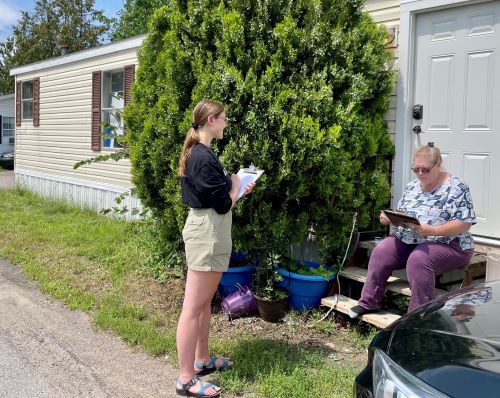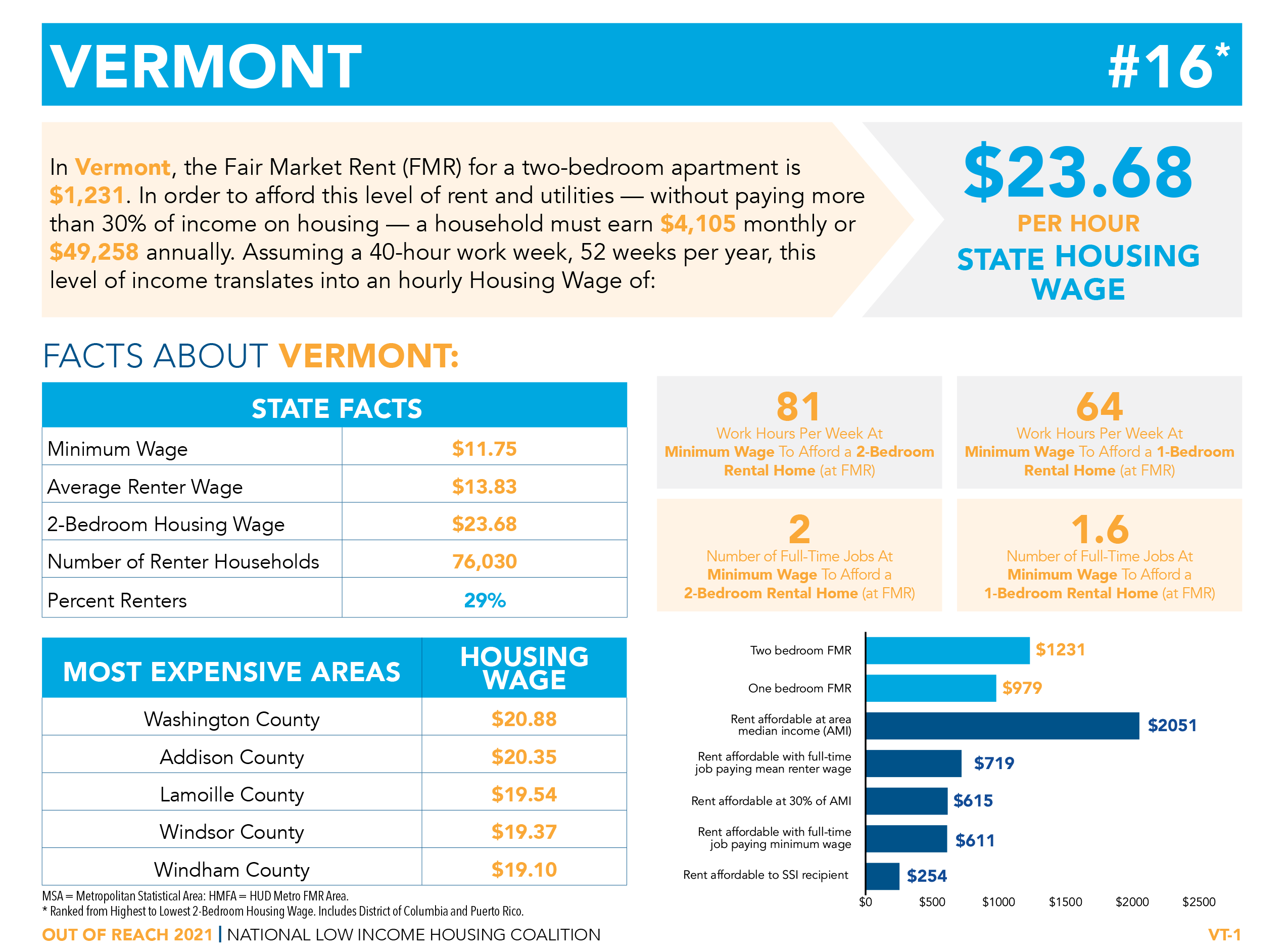Continue reading Housing Committees & Citizen Housing Advocacy
Voices of Home Visits Montpelier
The Center & the Margins:
High School Students of Burlington City & Lake Semester Consider the Issue of Homelessness & Inclusive Housing
System-busting through activism
Building Homes Together Campaign Concludes with Unfinished Business: More Work Lies Ahead
Equity and Land Use in South Burlington
Reflections on a summer of Housing Advocacy with CVOEO
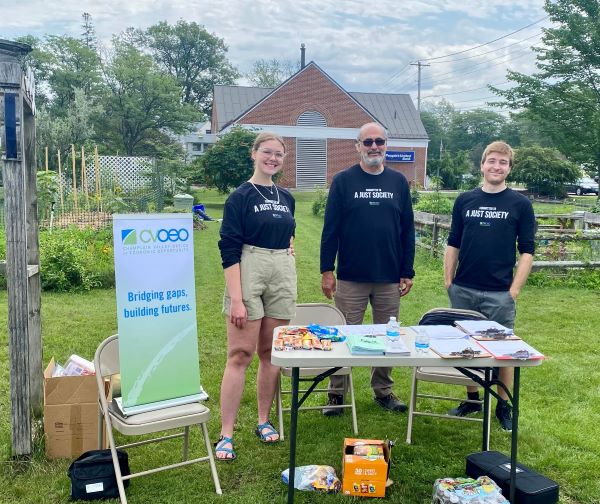
*This is an excerpt from Michelle Morgan’s final report on her summer internship with CVOEO‘s Housing Advocacy Programs (HAP). Michelle is a sophomore at Washington and Lee University. This summer, she worked primarily with the Mobile Home Program and assisted with other HAP activities. We are grateful for her thoughtful and enthusiastic approach to the work and for the contributions she made to the HAP programs during her internship.*
By Michelle Morgan
Shepherd Higher Education Consortium on Poverty (SHECP) Intern
I came into this internship knowing close to nothing about the intersections of poverty and manufactured housing – but I did come into this internship eager to learn; though I’ve never lived in a mobile home myself, I grew up in a rural, agricultural area of the country where they are a significant source of affordable housing. I was quick to find out during my first few days in the Mobile Home Program that mobile homes make up a significant source of affordable housing everywhere, which was only surprising to me in the sense that I was shocked at the lack of recognition they receive as such. Through working and talking with my team members, reading the 2018 Esther Sullivan ethnography Manufactured Insecurity, and engaging in directed research on state and local legislation regarding mobile homes and mobile home parks, I am happy to say that I will close this internship with a heartfelt understanding of the incredible importance of manufactured housing – not only when pertaining to low-income populations themselves, but in conversations regarding the affordable/fair housing crisis at large, and what solutions or pathways can be undertaken to help resolve it.
I am fortunate to have been able to gain this understanding at CVOEO in the state of Vermont, which I’ve come to know is on the vanguard of mobile home rights, regulations, and tenant-landlord responsibilities. Elsewhere in the country, and indeed in some parts of Vermont, mobile home residents live in a limbo between homeownership and land rentership, leaving them highly vulnerable to park sales, evictions, and rampant lot rent increases. The nature of manufactured housing also creates a limbo between permanence and mobility: many ‘mobile’ homes are actually immobile, with either structural deficiencies making them impossible to move without falling apart, transportation services costing thousands of dollars, or the straightforward issue of simply not having another lot to move the home to. On the converse, the ‘mobile’ aspect of manufactured housing often creates a fractured or unstable sense of ‘home’ and permanence that is essential to secure housing, while at the same time isolating mobile home parks and residents from the rest of the community due to structurally reinforced stigma and preconceived, stereotype-enforced bias against manufactured housing and the people that live in it.
Vermont, however, is unique in its recognition of the importance of mobile homes as a source of affordable housing security, with a variety of laws and regulations in place to prevent exorbitant rent increases and surprise park sales; the state, in coordination with organizations such as CVOEO and the Cooperative Development Institute (CDI), supports and offers help with the transition of parks from private to cooperative or nonprofit ownership, in which the park becomes owned by either the residents themselves or a housing trust. But this certainly does not mean that Vermont is perfect when it comes to protecting and empowering mobile home residents. I found this out within my first week or so of working here, through calling residents on the phone to have them complete a survey. While guiding residents through this survey over the phone, I heard time and time again concerns surrounding lot rent, community leadership and organization, quality of life, and long-term sustainability of the park in the market and in the community at large. Keep in mind that the residents I contacted lived in cooperatively-owned parks, which are considered to be the crème de la crème of mobile home communities in regards to resident advocacy and empowerment. So, I witnessed firsthand, right off the bat, that there remain miles and miles of progress to be made before fair, affordable, and secure housing is accessible and enjoyable for all.
I am more honored than anything to have been able to spend my summer contributing to closing that gap, even if only in small baby steps. Keeping in contact and conversation with my Shepherd Program Professional Learning Community (PLC) cohort, I recognize that I was incredibly fortunate to be able have an in-person internship, and that this aspect was crucial for the amount of agency involvement I was able to have, as well as the level of community involvement and engagement I experienced while living and working fully immersed in the greater Burlington community. Here are some of my proudest accomplishments from my time at CVOEO:
- Expanded on the Mobile Home Program’s Civic Engagement & Emergency Preparedness Pilot Program by developing a Community Outreach Plan for the project’s second phase, which ultimately aims to build community cohesion and relationships.
- Helped complete the final version of the first-phase project report.
- Created a data-driven map on Google Earth Pro of all mobile home parks in Vermont as listed on the state registry, including the nature of ownership, park size, lot rent, and owning body.
- Wrote a resident survey for preliminary feedback collection at parks, intended to gauge interest level for continued CVOEO involvement.
- Participated in on-the-ground community outreach, during which I went door-to-door with one of my supervisors and had the opportunity to have conversations with mobile home community members in person.
- Designed promotional materials for the Fair Housing Project’s Community Housing Discrimination Survey.
- Participated in a monthly discussion group with the Housing Advocacy Programs team about Keeanga-Yamahtta Taylor’s 2019 book Race for Profit.
All that I’ve learned about community, care, empathy, understanding, and action – within and without the workplace – has left an immense mark on my life: my story, my beliefs, my motivations, my passions, what drives me forward as a person. Here, in Burlington, through this internship, I’ve felt love, joy, kindness, generosity, compassion, warmth, and welcoming beyond what I could have ever imagined. I’ve been given the space and freedom to explore the depth and breadth of my capabilities both professionally and personally; my contributions have not been constrained by my status as merely “The Intern.” My coworkers and supervisors welcomed me into the team with open arms and cultivated a space and environment where meaningful, lasting work could come to be. My time in the Mobile Home Program has encouraged me to be the best person I can be, to do the best work I can do, to make the most difference I can make.
What I’m Coming Away With
My time at CVOEO has opened so many doors and illuminated endless opportunities in my life; it has changed my outlook on the world and the people that inhabit it; it has strengthened the values I hold dear to my heart, expanded on my personal abilities and professional skills, and illuminated my direction and purpose. Given that I’m still 18 years old, I think it’s fair to say that this internship – my first internship, something I never imagined would come along after only a year of college – has been my coming-of-age moment. Eight weeks of working in a nonprofit on the development and implementation of a project that has the potential to improve the livelihoods of mobile home park residents across Vermont, having my contributions acknowledged seriously and built upon, being able to go out into the community and interact with the people my agency serves – all of it, every little bit of it, has served to make it more clear than ever what I can accomplish, what I stand for, what I believe, what I find meaningful, who I am. It is, I believe, the true purpose of my existence to do as much good and spread as much positivity as humanly possible within my means. This internship has been fulfilling on a spiritual level, and has enabled me to dedicate myself to following my dreams and working toward the ultimate end goals of my life at large. CVOEO and the Mobile Home Program have taught me that not all the world is as bad as it may seem, especially during times like these. No, I can’t give up on humanity yet, because I’ve gotten to work with and know personally a handful of those people nationwide who dedicate their time and build their career around helping others. I feel blessed to have been a part of something so crucial to the integrity and empowerment of the Burlington community and beyond.
The Shepherd Higher Education Consortium on Poverty (SHECP) encourages the study of poverty as a complex social problem, by expanding and improving educational opportunities for college students in a wide range of disciplines and career trajectories. Through its programs, SHECP and its member institutions prepare students for a lifetime of professional and civic efforts to diminish poverty and enhance human capability, while also supporting connections among students, faculty, staff, and alumni engaged in the study of poverty.
What does the new CDC Eviction Moratorium Mean for Vermont?
This Q & A was created by Jessica Radbord, Esq. of Vermont Legal Aid
The CDC issued a new order temporarily halting evictions in counties with substantial levels of COVID transmission. As of Aug. 5, Bennington, Chittenden, Franklin, Grand Isle, Orleans, and Washington counties are covered. You can find the covered counties on this map: https://covid.cdc.gov/covid-data-tracker/#county-view.
-
How long does the new eviction moratorium last?
-
Until October 3 at the latest, unless a court strikes it down sooner.
-
If, at any point, a county no longer experiences a substantial rate of transmission, the moratorium will expire 14 days later (unless we return to substantial transmission rates during that 14 day period, and then it kicks back in).
-
-
What does the new eviction moratorium do?
-
- It bars a landlord from filing an eviction case if the tenant has asserted their rights under the moratorium. It also stays nonpayment eviction cases already filed if the tenant has asserted their rights.
- NOTE: If a case or notice of termination is for both nonpayment and breach, the case could still move forward based on the breach.
-
Does the new eviction moratorium apply to all eviction cases?
-
- No. It only applies to evictions for nonpayment of rent for eligible tenants who have asserted their rights.
-
Are all tenants eligible?
-
- No. They have to meet the eligibility criteria on the Eviction Protection Declaration Form. The tenant MUST give the form to their landlord to assert their rights to the protection. The tenant should keep a copy of the form. If there’s already a case pending in court, they should submit a copy to the court.
-
-
- If the tenant has a case pending in court, the tenant should call Legal Services Vermont/Vermont Legal Aid at 800-889-2047. When they leave a message, they should say that they have a pending eviction case and their county
-
-
- NOTE: If the tenant is exercising their rights under the moratorium, they are swearing to try to access all forms of rental assistance available. And here in Vermont, that’s VERAP. If the tenant refuses to apply for rental assistance, they should not use the form. They must follow through with applying for VERAP if they are asserting their rights under the moratorium.
-
Should tenants get legal advice before using the form?
- Sure, if they want! Call Legal Services Vermont/Vermont Legal Aid at 800-889-2047. Leave a message as the intake staff are not taking live calls. It can take up to 7 business days to get a callback because of an extremely high call volume. If a tenant is running up against a deadline, they should indicate in their voicemail what deadline is coming up. The intake staff tries to prioritize callbacks where the person identifies a critical deadline. But for the most part, if the person qualifies based on the simple questions on the form and is willing to apply for VERAP, I don’t see a reason not to use it.
The full text of the new eviction moratorium is here: https://www.cdc.gov/coronavirus/2019-ncov/communication/Signed-CDC-Eviction-Order.pdf.
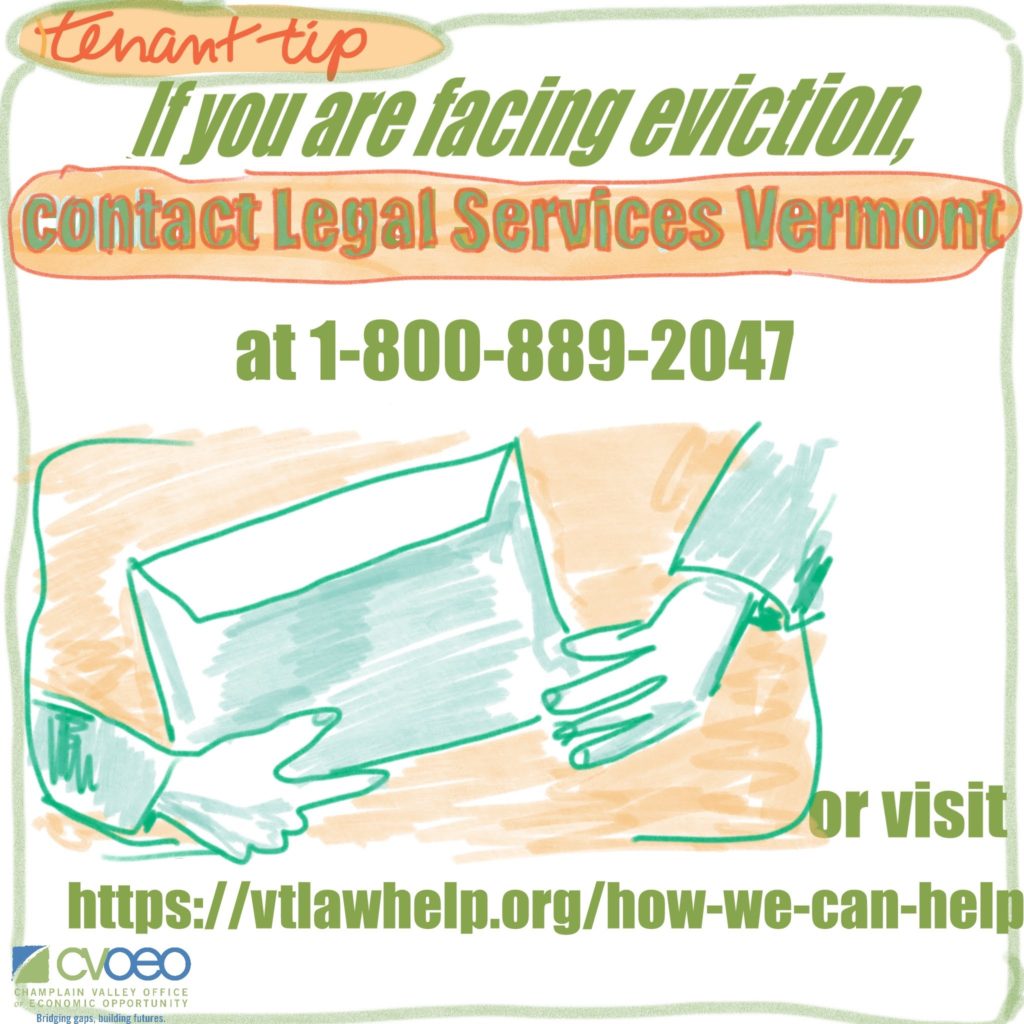
New video highlights issues Vermonters face accessing safe, quality, accessible & affordable housing
It’s not a secret — Vermont is experiencing a housing crisis. There’s so much going on (high rents, escalating home prices, motel vouchers, eviction moratoriums, mobile home park affordability, housing discrimination) it can be hard to know what’s happening and what we can do about it.
Four housing advocates join the Vermont Affordable Housing Coalition (VAHC) in this video series to highlight some of issues Vermont residents face accessing safe, quality, accessible and affordable housing—and how we must keep these multiple issues in mind as we increase investment in housing.
The video covers mobile home infrastructure with CVOEO’s former Mobile Home Program Resident Organizer Laura Mistretta; evictions in the aftermath of COVID19 with CVOEO’s Vermont Tenants Advocate Madeline Roberts; fair housing and discrimination with CVOEO Fair Housing Project Education and Outreach Coordinator Corrine Yonce, and broadband access with Evernorth Director of Asset Management Rewa Worthington.
In the words of CVOEO’s Corrine Yonce, “The creation of housing that starts happening this fall and will continue for a couple years because of this [federal] funding influx is going to impact the housing landscape and the overall community landscape of Vermont for decades to come. … We need to make sure that our new housing being created actually enables housing choice.”
NLIHC’s Out of Reach Report tells us what we already know: Vermont has a growing affordability problem – Here’s what we can do about it.
The recent release of the National Low Income Housing Coalition’s Out of Reach report shows that Vermont has the sixth largest shortfall between the average renter wage and the two-bedroom housing wage. In the Burlington/ South Burlington region, where the 2-bedroom housing wage jumps from the state’s average of $23.68 to $31.31, the housing wage gap is particularly acute. This means that full-time employees living in Burlington and South Burlington have to make $31.31per hour in order not to spend more than 30% of their income on rent. Meanwhile, the average hourly wage for Vermont renters is $13.83.
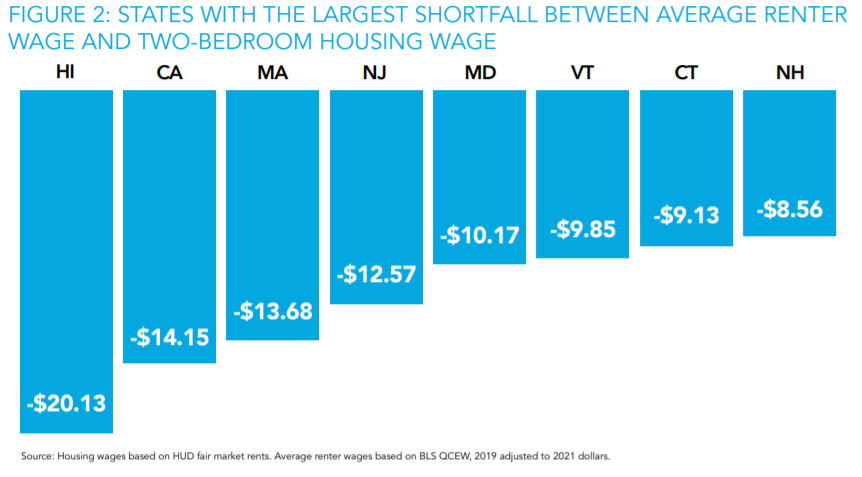
“We’ve been in the midst of a chronic affordable housing crisis for many, many years,” Kerrie Lohr of Lamoille Housing Partnership, asserted to VTDigger earlier this week, “This report pretty much shows what we already know to be true, is that housing is out of reach for many of Vermont’s renters.” What housing advocates have been seeking to address over the course of Vermont’s long housing affordability history crisis has become especially acute during this past year. While Vermont’s housing sales spiked 38% this past year, many of these new residents purchased with cash-on-hand, often significantly over the asking price, with sales of million dollar homes almost tripling.
These numbers are particularly concerning when we turn an eye to Vermont’s pattern of racial inequity. This year saw rates of COVID doubling in communities of color, highlighting the disparities in health and economic opportunities for People of Color in Vermont. Nationally, the home ownership rate of White households is 70% to the 41% of Back homeowners, a gap caused and reinforced by a pervasive history of racist housing policies, inequal lending, and lack of meaningful policy change to address this systemic problem. Vermont’s homeownership gap is much larger with only 21% of Black households owning their home compared to 72% of white households. Local student activist (and current Fair Housing Project intern) Minelle Sarfo-Adu spoke to VPR about experiencing this stark disparity in her South Burlington community, “I think I only have two African American friends in the whole — like in all Vermont, that actually own homes,” she said. “Other than that, every other one of my friends actually rents, unless they’re white. All my white friends actually own their homes.”
The severe affordability crisis in Vermont creates an environment where landlords can be more discriminative in who they rent to. For renters who belong to the Fair Housing protected classes and face the greatest barriers to housing access in our state, this means longer and more desperate housing searches. While housing advocates are certain that most discrimination goes unreported, testing performed by the Housing Discrimination Law Project of Vermont Legal Aid indicates that housing providers generally disfavor African American renters, renters of foreign origin, renters with children and renters with disabilities. Reports from the CVOEO Vermont Tenants hotline and housing community forums are riddled with stories of people being turned away from housing because of a housing voucher or for having children (both violations of the Fair Housing Act in Vermont), and of desperate housing decisions such as signing leases before viewing the property or even offering to pay more than the listed monthly rent.
So what do we do about it?
“Treat the housing emergency like an emergency,” retorts the collective voice of Anne N. Sosin, Mairead O’Reilly, and Maryellen Griffin in their recent VTDigger commentary, “Housing is a Public Health Crisis in Vermont.” Sosin is a policy fellow at the Nelson A. Rockefeller Center at Dartmouth College; O’Reilly is a medical legal partnership attorney at Vermont Legal Aid; and Griffin is a housing attorney at Vermont Legal Aid. Housing activists, policy makers, and the broader population of Vermont need to act now to address this growing problem, they wrote as they shared the major lessons housing advocates have gleaned from this past year of COVID response. Their voice has urgency, as some key opportunities to enhance renter protections have already passed. These key missed advocacy moments include the veto of the Rental Housing Safety Bill and a failure to delay the ending of the State of Emergency – which had expanded shelter space for houseless folks through federal CARES funding – until more rental housing was made available. Some economists and sustainable communities experts caution this trend is only at its early fruition as climate change pushes folks from more geographically vulnerable locations.
Much of what Sosin, O’Reilly, and Griffin called for is still possible. “Mobilize a statewide response,” they stated, noting that these solutions will be unique to the region and therefore require regional solutions. Our Fair Housing Friday panelists this spring noted that creative solutions require broad civic engagement, especially from those most impacted by the growing inequity of available resources. Housing Committees are a critical tool to mobilizing regional solutions to a statewide problem and can jumpstart conversations at the community level. The common thread running through all these solutions is that they must center the needs of the communities consistently facing the highest barriers to housing.
